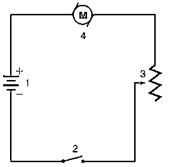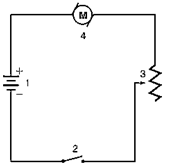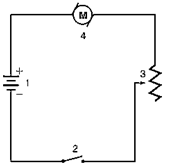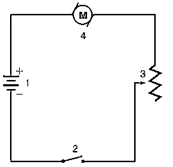
a.
The device which transforms electrical energy to mechanical energy.
a.
Explanation of Solution
Introduction:
A motor converts electrical energy into mechanical energy.

Device number 4 in the figure is the motor which converts electrical energy into mechanical energy.
b.
The device which transforms chemical energy to electrical energy.
b.
Explanation of Solution
Introduction:
A battery converts chemical energy to electrical energy.

Device number 1 in the figure is the battery which converts chemical energy to electrical energy.
c.
The device which turns the circuit on and off.
c.
Explanation of Solution
Introduction:
A key is used in a circuit to turn it on and off.

Device number 2 in the fig is the key which turns the circuit on and off.
d.
The device whichprovides a way to adjust the speed.
d.
Explanation of Solution
Introduction:
A rheostat is a device used to control current by varying the resistance.

Device number 3 in the figure is the rheostat which is used to control current by varying the resistance. For more speed more current is required. From Ohm’s law,
Conclusion:
Device number 3 in the figure is the rheostat which is used to control current by varying the resistance.
Chapter 22 Solutions
Glencoe Physics: Principles and Problems, Student Edition
Additional Science Textbook Solutions
Campbell Biology in Focus (2nd Edition)
Human Anatomy & Physiology (2nd Edition)
Chemistry: The Central Science (14th Edition)
Campbell Biology: Concepts & Connections (9th Edition)
Introductory Chemistry (6th Edition)
Organic Chemistry (8th Edition)
- A Van de Graff generator, if the metal sphere on the Van de Graff has a charge of 0.14 Coulombs and the person has a mass of 62 kg, how much excess charge would the person need in order to levitate at a distance 25 cm from the center of the charged metal sphere? Assume you can treat both the person and the metal sphere as point charges a distance 25 cm from each other using Coulomb's Law to calculate the electrical force. Give your answer as the number of Coulombsarrow_forwardPlease help me answer the following question. I am having trouble understanding the directions of the things the question is asking for. Please include a detailed explanation and possibly drawings of the directions of Bsource, Binduced, and Iinduced.arrow_forward43. A mass må undergoes circular motion of radius R on a hori- zontal frictionless table, con- nected by a massless string through a hole in the table to a second mass m² (Fig. 5.33). If m₂ is stationary, find expres- sions for (a) the string tension and (b) the period of the circu- lar motion. m2 R m₁ FIGURE 5.33 Problem 43arrow_forward
- CH 70. A block is projected up an incline at angle 0. It returns to its initial position with half its initial speed. Show that the coefficient of ki- netic friction is μk = tano.arrow_forwardPassage Problems A spiral is an ice-skating position in which the skater glides on one foot with the other foot held above hip level. It's a required element in women's singles figure-skating competition and is related to the arabesque performed in ballet. Figure 5.40 shows Canadian skater Kaetlyn Osmond executing a spiral during her medal-winning perfor- mance at the 2018 Winter Olympics in Gangneung, South Korea. 77. From the photo, you can conclude that the skater is a. executing a turn to her left. b. executing a turn to her right. c. moving in a straight line out of the page. 78. The net force on the skater a. points to her left. b. points to her right. c. is zero. 79. If the skater were to execute the same maneuver but at higher speed, the tilt evident in the photo would be a. less. b. greater. c. unchanged. FIGURE 5.40 Passage Problems 77-80 80. The tilt angle 0 that the skater's body makes with the vertical is given ap- proximately by 0 = tan¯¹(0.5). From this you can conclude…arrow_forwardFrictionless surfarrow_forward
- 71. A 2.1-kg mass is connected to a spring with spring constant 72 k = 150 N/m and unstretched length 18 cm. The two are mounted on a frictionless air table, with the free end of the spring attached to a frictionless pivot. The mass is set into circular mo- tion at 1.4 m/s. Find the radius of its path. cor moving at 77 km/h negotiat CH —what's the minimum icient of frictioarrow_forward12. Two forces act on a 3.1-kg mass that undergoes acceleration = 0.91 0.27 m/s². If one force is -1.2î – 2.5ĵ N, what's the other?arrow_forward36. Example 5.7: You whirl a bucket of water around in a vertical circle of radius 1.22 m. What minimum speed at the top of the circle will keep the water in the bucket?arrow_forward
- Passage Problems Laptop computers are equipped with accelerometers that sense when the device is dropped and then put the hard drive into a protective mode. Your computer geek friend has written a program that reads the accel- erometer and calculates the laptop's apparent weight. You're amusing yourself with this program on a long plane flight. Your laptop weighs just 5 pounds, and for a long time that's what the program reports. But then the "Fasten Seatbelt" light comes on as the plane encounters turbu- lence. Figure 4.27 shows the readings for the laptop's apparent weight over a 12-second interval that includes the start of the turbulence. 76. At the first sign of turbulence, the plane's acceleration a. is upward. b. is downward. c. is impossible to tell from the graph. 77. The plane's vertical ac- celeration has its greatest magnitude a. during interval B. b. during interval C. c. during interval D. 78. During interval C, you can conclude for certain that the plane is Apparent…arrow_forwardIf the metal sphere on the Van de Graff has a charge of 0.14 Coulombs and the person has a mass of 62 kg, how much excess charge would the person need in order to levitate at a distance 25 cm from the center of the charged metal sphere? Assume you can treat both the person and the metal sphere as point charges a distance 25 cm from each otherarrow_forwardIf the metal sphere on the Van de Graff has a charge of 0.14 Coulombs and the person has a mass of 62 kg, how much excess charge would the person need in order to levitate at a distance 25 cm from the center of the charged metal sphere? Assume you can treat both the person and the metal sphere as point charges a distance 25 cm from each other (so that you can use Coulomb's Law to calculate the electrical force).arrow_forward
 College PhysicsPhysicsISBN:9781305952300Author:Raymond A. Serway, Chris VuillePublisher:Cengage Learning
College PhysicsPhysicsISBN:9781305952300Author:Raymond A. Serway, Chris VuillePublisher:Cengage Learning University Physics (14th Edition)PhysicsISBN:9780133969290Author:Hugh D. Young, Roger A. FreedmanPublisher:PEARSON
University Physics (14th Edition)PhysicsISBN:9780133969290Author:Hugh D. Young, Roger A. FreedmanPublisher:PEARSON Introduction To Quantum MechanicsPhysicsISBN:9781107189638Author:Griffiths, David J., Schroeter, Darrell F.Publisher:Cambridge University Press
Introduction To Quantum MechanicsPhysicsISBN:9781107189638Author:Griffiths, David J., Schroeter, Darrell F.Publisher:Cambridge University Press Physics for Scientists and EngineersPhysicsISBN:9781337553278Author:Raymond A. Serway, John W. JewettPublisher:Cengage Learning
Physics for Scientists and EngineersPhysicsISBN:9781337553278Author:Raymond A. Serway, John W. JewettPublisher:Cengage Learning Lecture- Tutorials for Introductory AstronomyPhysicsISBN:9780321820464Author:Edward E. Prather, Tim P. Slater, Jeff P. Adams, Gina BrissendenPublisher:Addison-Wesley
Lecture- Tutorials for Introductory AstronomyPhysicsISBN:9780321820464Author:Edward E. Prather, Tim P. Slater, Jeff P. Adams, Gina BrissendenPublisher:Addison-Wesley College Physics: A Strategic Approach (4th Editio...PhysicsISBN:9780134609034Author:Randall D. Knight (Professor Emeritus), Brian Jones, Stuart FieldPublisher:PEARSON
College Physics: A Strategic Approach (4th Editio...PhysicsISBN:9780134609034Author:Randall D. Knight (Professor Emeritus), Brian Jones, Stuart FieldPublisher:PEARSON





